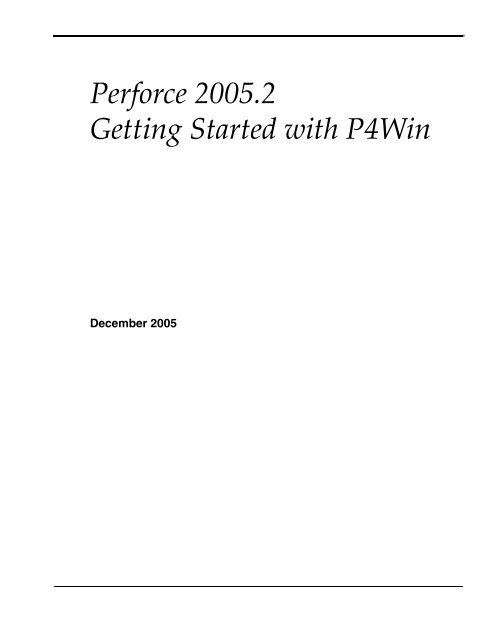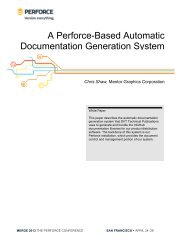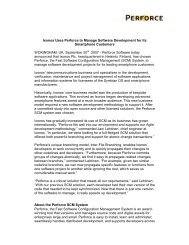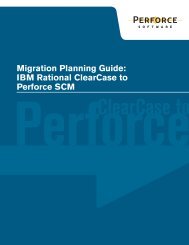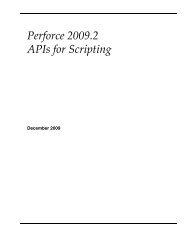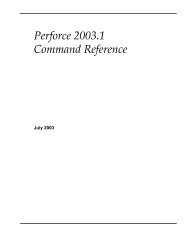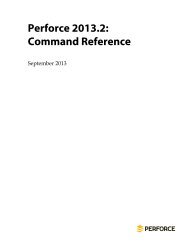Perforce 2005.2 Getting Started With P4Win
Perforce 2005.2 Getting Started With P4Win
Perforce 2005.2 Getting Started With P4Win
You also want an ePaper? Increase the reach of your titles
YUMPU automatically turns print PDFs into web optimized ePapers that Google loves.
<strong>Perforce</strong> <strong>2005.2</strong><br />
<strong>Getting</strong> <strong>Started</strong> with <strong>P4Win</strong><br />
December 2005
This manual copyright 2003-2005 <strong>Perforce</strong> Software.<br />
All rights reserved.<br />
<strong>Perforce</strong> software and documentation is available from http://www.perforce.com. You may download and use<br />
<strong>Perforce</strong> programs, but you may not sell or redistribute them. You may download, print, copy, edit, and redistribute<br />
the documentation, but you may not sell it, or sell any documentation derived from it. You may not modify or attempt<br />
to reverse engineer the programs.<br />
<strong>Perforce</strong> programs and documents are available from our Web site as is. No warranty or support is provided. Warranties<br />
and support, along with higher capacity servers, are sold by <strong>Perforce</strong> Software.<br />
<strong>Perforce</strong> Software assumes no responsibility or liability for any errors or inaccuracies that may appear in this book.<br />
By downloading and using our programs and documents you agree to these terms.<br />
<strong>Perforce</strong> and Inter-File Branching are trademarks of <strong>Perforce</strong> Software. <strong>Perforce</strong> software includes software developed<br />
by the University of California, Berkeley and its contributors.<br />
All other brands or product names are trademarks or registered trademarks of their respective companies or organizations.
Table of Contents<br />
<strong>Getting</strong> <strong>Started</strong> with <strong>P4Win</strong>......................................... 5<br />
Basic Concepts.....................................................................................................5<br />
<strong>Perforce</strong> Specifications .......................................................................................6<br />
Basic Tasks ...........................................................................................................6<br />
The <strong>P4Win</strong> Screen ...............................................................................................7<br />
The Depot Pane ..............................................................................................8<br />
The Right Pane..............................................................................................10<br />
The Toolbar....................................................................................................11<br />
The Status Pane.............................................................................................11<br />
<strong>P4Win</strong> Forms.................................................................................................12<br />
<strong>Getting</strong> Information .....................................................................................13<br />
Setting Up and Using <strong>P4Win</strong> ..........................................................................13<br />
Connecting to a server.................................................................................14<br />
Creating a workspace ..................................................................................17<br />
Adding files to the depot ............................................................................18<br />
Copying files from the depot to the workspace.......................................19<br />
Editing files ...................................................................................................20<br />
Displaying changes (diffing) ......................................................................21<br />
Discarding changes (reverting) ..................................................................22<br />
Submitting changes......................................................................................23<br />
Deleting files .................................................................................................24<br />
Important and Useful Features.......................................................................26<br />
Right-clicking and context menus .............................................................26<br />
Configuring <strong>P4Win</strong> ......................................................................................27<br />
Using drag and drop....................................................................................28<br />
Beyond the Basics .............................................................................................29<br />
<strong>Perforce</strong> <strong>2005.2</strong> <strong>Getting</strong> <strong>Started</strong> with <strong>P4Win</strong> 3
Table of Contents<br />
4 <strong>Perforce</strong> <strong>2005.2</strong> <strong>Getting</strong> <strong>Started</strong> with <strong>P4Win</strong>
<strong>Getting</strong> <strong>Started</strong> with <strong>P4Win</strong><br />
<strong>P4Win</strong> is a Windows-Explorer-style program that helps you manage files that are stored<br />
in the <strong>Perforce</strong> software configuration management system. Using <strong>P4Win</strong>, you can view<br />
files, check them in and out, compare them, and handle conflicts that arise in team<br />
development settings. <strong>P4Win</strong> is highly configurable, and you can add custom tools to the<br />
<strong>P4Win</strong> menu to perform specialized tasks.<br />
This guide helps you get started with <strong>P4Win</strong>, and tells you how to perform the basic tasks<br />
you’re likely to want to do on the first day you start working with <strong>P4Win</strong>. However, to<br />
really know what’s going on, you need to understand <strong>Perforce</strong> in detail. For an overview<br />
of <strong>Perforce</strong>, read Introducing <strong>Perforce</strong>. For details about using <strong>P4Win</strong>, refer to its online<br />
help system: from the <strong>P4Win</strong> Help menu, choose the Help Topics menu item, or press the<br />
F1 key.<br />
Basic Concepts<br />
<strong>P4Win</strong> connects to a <strong>Perforce</strong> server to move files between <strong>Perforce</strong> depots and your<br />
workspace, as shown below.<br />
Workspaces store<br />
local copies of files<br />
on...<br />
...your computer,<br />
running P4V, which<br />
connects to...<br />
...the <strong>Perforce</strong> Server,<br />
which manages...<br />
...depots, repositories<br />
of files under<br />
<strong>Perforce</strong> control<br />
The precise definitions for these <strong>Perforce</strong> terms are as follows:<br />
• depot: a file repository on the <strong>Perforce</strong> server. It contains all existing versions of all files<br />
ever submitted to the server. There can be multiple depots on a single server. The<br />
examples in this guide show a single depot.<br />
• server: the program that executes the commands sent by client programs, maintains<br />
depot files, and tracks the state of workspaces.<br />
<strong>Perforce</strong> <strong>2005.2</strong> <strong>Getting</strong> <strong>Started</strong> with <strong>P4Win</strong> 5
<strong>Perforce</strong> Specifications<br />
• workspace: folders on the client computer where you work on revisions of files that are<br />
managed by <strong>Perforce</strong>.<br />
<strong>Perforce</strong> Specifications<br />
In addition to files, <strong>P4Win</strong> lets you manage specifications that define the following<br />
<strong>Perforce</strong> entities:<br />
Name<br />
Changelist<br />
Client<br />
User<br />
Job<br />
Label<br />
Branch<br />
Basic Tasks<br />
Description<br />
A group of files, with a description explaining how you’ve changed<br />
them (for example, “Fix bug 000123”). Changelists are assigned<br />
numbers by the <strong>Perforce</strong> Server so you can track them.<br />
A specification describing a workspace and specifying how files in the<br />
depot are mapped to locations in the workspace.<br />
The identifier that <strong>Perforce</strong> uses to track who is performing an<br />
operation.<br />
A user-defined unit of work tracked by <strong>Perforce</strong>. You can associate jobs<br />
with changelists to track when and how the work is done.<br />
A tag you can apply to file revisions in the depot, to group related files.<br />
A specification used to copy a group of related files, for example, to<br />
create a software release.<br />
The following <strong>Perforce</strong> terms describe basic tasks you frequently perform using <strong>P4Win</strong>.<br />
When you...<br />
Sync a file<br />
Open a file<br />
Revert a file<br />
Submit a changelist<br />
What you’re doing is...<br />
Retrieving a copy of a file version from the depot.<br />
Notifying the server that you are changing the file. You can open<br />
files for add, edit, or delete. When you open a file, the file is added<br />
to a changelist.<br />
Discarding any changes you have made to an open file. If you open<br />
a file for edit and make changes, then change your mind and revert<br />
the file, <strong>P4Win</strong> reloads the last version you got from the depot and<br />
discards your changes.<br />
Updating the depot to reflect any changes you’ve made to open<br />
files. Submitting is an all-or-nothing operation: if there’s a problem<br />
submitting one file in a changelist, none of the other files in the<br />
changelist are updated.<br />
6 <strong>Perforce</strong> <strong>2005.2</strong> <strong>Getting</strong> <strong>Started</strong> with <strong>P4Win</strong>
The <strong>P4Win</strong> Screen<br />
The <strong>P4Win</strong> Screen<br />
The <strong>P4Win</strong> screen resembles the Windows Explorer. The following diagram points out<br />
the main portions of the screen. Each pane is described in detail in the following sections.<br />
Toolbar: buttons for changing panes and<br />
performing common operations<br />
Depot pane: shows files in the depot<br />
Right pane: shows changelists,<br />
jobs, users, clients, branch specs<br />
or labels<br />
Status line: displays status and file<br />
information<br />
Status pane: shows operations and<br />
results<br />
<strong>Perforce</strong> <strong>2005.2</strong> <strong>Getting</strong> <strong>Started</strong> with <strong>P4Win</strong> 7
The <strong>P4Win</strong> Screen<br />
The Depot Pane<br />
Depot contents are displayed in a tree in the left pane.<br />
Depots contain... folders, which contain... files.<br />
File icons display a lot of detail about file type and status.<br />
For example, the file shown above is<br />
in your workspace at the most recent<br />
revision (green dot), and<br />
a text file (lines on icon)<br />
Here’s another file icon, showing a file that is...<br />
checked out by you,<br />
locked for submission,<br />
and you have an old version in<br />
your workspace (represented by<br />
the “!”).<br />
The text to the right of the file icon<br />
tells you the revision in your<br />
workspace, latest revision in the<br />
depot, and <strong>Perforce</strong> file type<br />
For more<br />
information...<br />
...about file icons, see the online help topic “About File Icons” in the<br />
section “Using the <strong>P4Win</strong> Interface.”<br />
8 <strong>Perforce</strong> <strong>2005.2</strong> <strong>Getting</strong> <strong>Started</strong> with <strong>P4Win</strong>
The <strong>P4Win</strong> Screen<br />
Some navigation hints:<br />
• Multiple selections: Shift-click to select contiguous items, Ctrl-click to select noncontiguous<br />
items.<br />
• Select next/previous: Up and down arrows traverse the current level, and right and left<br />
arrows move the cursor up and down through the folder hierarchy.<br />
• Open a selected folder: Use the asterisk (*) key on the numeric keypad.<br />
You can control which files are displayed in the depot pane. For example, you might want<br />
to restrict the list of files to display only the files for the project you’re working on, or<br />
conversely, you might want to see every file in every depot. The scope is controlled by<br />
your client specification and the view you choose for the depot pane.<br />
Click here to choose which files are displayed in the depot pane.<br />
For more<br />
information...<br />
...about controlling the files displayed in the depot pane, see the online<br />
help topics “Managing the Main Window” and “Finding Files in the<br />
Depot” in the section “Using the <strong>P4Win</strong> Interface.”<br />
<strong>Perforce</strong> <strong>2005.2</strong> <strong>Getting</strong> <strong>Started</strong> with <strong>P4Win</strong> 9
The <strong>P4Win</strong> Screen<br />
The Right Pane<br />
The right pane displays changelists, jobs, client specifications, users, labels or branch<br />
specifications. To change the display, click the corresponding toolbar button.<br />
Pending changelists<br />
Submitted changelists<br />
Branch specifications<br />
Labels<br />
Jobs<br />
Users<br />
Client specifications<br />
At first, you’ll mostly be working with changelists, so here’s some more information<br />
about what’s displayed for pending changelists.<br />
Changelists are numbered for identification.<br />
The default changelist is assigned a number<br />
when you submit it.<br />
The triangles represent pending<br />
(unsubmitted) changelists. Yours are red:<br />
Other clients’ changelists are blue:<br />
You are required to enter a description<br />
before you submit a changelist. Your<br />
description enables you to track the<br />
reasons for changes.<br />
For more<br />
information...<br />
...about displaying information in the right pane, see the related<br />
“Displaying...” online help topic. For example, for details about<br />
displaying changelists, see “Displaying Changelists” in the section<br />
“Managing Files.”<br />
10 <strong>Perforce</strong> <strong>2005.2</strong> <strong>Getting</strong> <strong>Started</strong> with <strong>P4Win</strong>
The <strong>P4Win</strong> Screen<br />
The Toolbar<br />
The <strong>P4Win</strong> toolbar contains buttons that provide shortcuts for common <strong>P4Win</strong><br />
operations. However, there’s a menu equivalent for every button on the toolbar. Note that<br />
buttons are gray if an operation is not available. For example, some operations require<br />
you to select a file first. If no file is selected, the button (and the corresponding menu item)<br />
are gray. Here’s what the buttons do:<br />
Sync<br />
Open for<br />
edit<br />
Add<br />
Revert<br />
Lock<br />
Unlock<br />
Submit<br />
Display in right pane<br />
Open for<br />
delete<br />
Bookmarks<br />
Connections<br />
Revision history<br />
Diff with depot<br />
View<br />
Launch editor<br />
Stop operation<br />
Change settings<br />
Display server<br />
information<br />
If you forget what a button does, just position the cursor over the button to display a<br />
tooltip containing a brief explanation:<br />
The Status Pane<br />
In the status pane at the bottom of the screen, <strong>P4Win</strong> displays the commands it sends to<br />
the <strong>Perforce</strong> server, the results of operations, and, for some <strong>P4Win</strong> operations, lists of<br />
<strong>Perforce</strong> <strong>2005.2</strong> <strong>Getting</strong> <strong>Started</strong> with <strong>P4Win</strong> 11
The <strong>P4Win</strong> Screen<br />
information. For example, if you click this toolbar button: , <strong>P4Win</strong> display server<br />
information in the status pane, as shown in the following figure.<br />
User Name: tonyz<br />
Client Name: my-test-workspace<br />
Client Host: submariner<br />
Client Root: c:\p4clients<br />
Client Address: 10.0.0.255:1255<br />
Client Version: 2003.1 44428<br />
Client P4Charset:<br />
Client Ansi Code Page: 1252 (ANSI - Latin I)<br />
Server Address: 10.0.0.233:1999<br />
Server Date: 2003/05/20 13:12:59 -0700 PDT<br />
Server Version: P4D/FREEBSD4/2003.1beta/44243 (2003/04/25)<br />
Server License: <strong>Perforce</strong> Software 700 users (expires 2004/01/31)<br />
Server Root: /usr/archive/depot/p4-999<br />
Client OS: Microsoft® Windows XP(TM), Build 2600, Service Pack 1<br />
<strong>P4Win</strong> Forms<br />
To define changelists, users, workspaces, labels, jobs, and branches, you enter information<br />
into forms displayed by <strong>P4Win</strong>. For example, the following figure shows the changelist<br />
form.<br />
Click Spec Notes to<br />
display information<br />
about fields on forms<br />
Click Help to display<br />
the online help topic<br />
that explains tasks<br />
related to the form<br />
12 <strong>Perforce</strong> <strong>2005.2</strong> <strong>Getting</strong> <strong>Started</strong> with <strong>P4Win</strong>
Setting Up and Using <strong>P4Win</strong><br />
<strong>Getting</strong> Information<br />
Here’s where to look for information when using <strong>P4Win</strong>.<br />
• Tooltips: to get information about a button or a form field, position the cursor over the<br />
item in question. <strong>P4Win</strong> displays a popup containing a brief description of the button or<br />
field.<br />
• Spec Notes: to get detailed information about form fields, click the button.<br />
• Online help: to get instructions for performing tasks using <strong>P4Win</strong>, check the online<br />
help. To display online help, choose the Help Topics... menu item from the Help menu<br />
or press F1. Many dialogs include a Help button that takes you directly to the most<br />
closely-related help topic.<br />
• Status pane: to see the commands that <strong>P4Win</strong> sends to the server and the results that<br />
the server returns to <strong>P4Win</strong>, check the status pane. Some <strong>P4Win</strong> operations (like<br />
Help>Show Connection Info) display their output in the status pane.<br />
• Status line: displays local file paths and brief status messages.<br />
Setting Up and Using <strong>P4Win</strong><br />
This section tells you how to set up <strong>P4Win</strong> so you can perform some typical, basic SCM<br />
tasks. Before you start, ask your <strong>Perforce</strong> administrator for the following information:<br />
• Host and port of <strong>Perforce</strong> server. (Your administrator might want to create or direct you<br />
to a test server, to enable you to experiment without affecting an in-use depot.)<br />
• Your <strong>Perforce</strong> user name.<br />
• Your <strong>Perforce</strong> client specification (workspace) name, if one exists.<br />
The following sections tell you how to perform these basic tasks.<br />
• Connecting to a server: to interact with a depot, you must configure <strong>P4Win</strong> with the<br />
server host and port, and specify the user and client workspace you want to use.<br />
• Creating a workspace: if your <strong>Perforce</strong> administrator hasn’t already done this, you need<br />
to configure an area where you store working copies of files from the depot.<br />
• Adding files to the depot: add files you create in your workspace to the depot so other<br />
users have access to them.<br />
• Copying files from the depot to the workspace: retrieve copies of files created by other<br />
users and stored in the depot.<br />
• Editing files: check out and change files that you retrieved.<br />
<strong>Perforce</strong> <strong>2005.2</strong> <strong>Getting</strong> <strong>Started</strong> with <strong>P4Win</strong> 13
Setting Up and Using <strong>P4Win</strong><br />
• Displaying changes (diffing): compare different version of files to see what has<br />
changed.<br />
• Discarding changes: revert to the version of a file you retrieved from the depot and<br />
overwrite any changes you have made.<br />
• Submitting changes: check in a file that you changed by submitting the changelist in<br />
which the file is open.<br />
• Deleting files: mark a file in the depot as “deleted.” Note that, in <strong>Perforce</strong>, previous<br />
revisions are still accessible.<br />
The examples in the following section use an example depot. Naturally, your own depot<br />
will contain different files and have a different structure.<br />
If you have questions or want more information about the tasks in the following sections,<br />
consult the <strong>P4Win</strong> online help (press F1), the <strong>Perforce</strong> user documentation (available on<br />
our Web site), or contact <strong>Perforce</strong> Technical Support.<br />
Connecting to a server<br />
1. Launch <strong>P4Win</strong>: from the Windows Start menu, choose Program<br />
Files><strong>Perforce</strong>><strong>P4Win</strong>.<br />
14 <strong>Perforce</strong> <strong>2005.2</strong> <strong>Getting</strong> <strong>Started</strong> with <strong>P4Win</strong>
Setting Up and Using <strong>P4Win</strong><br />
If <strong>P4Win</strong> has never been run on your computer and no client workspace exists,<br />
<strong>P4Win</strong> displays the following dialog (with the name of your computer and login in<br />
place of “my-workspace” and “my-user”).<br />
If this dialog is displayed, click Cancel to dismiss it. You can define a workspace<br />
later.<br />
2. Choose Settings...>Switch Port Client User... <strong>P4Win</strong> displays a dialog where you<br />
specify connection settings.<br />
3. Enter the required connection information as follows:<br />
• Port: the server name and port number using the format server:port#<br />
• Client: the name of your client specification (which describes your workspace)<br />
• User: your <strong>Perforce</strong> user name (if your system administrator hasn’t created one for<br />
you, <strong>Perforce</strong> creates the specified user when you connect to the server)<br />
<strong>Perforce</strong> <strong>2005.2</strong> <strong>Getting</strong> <strong>Started</strong> with <strong>P4Win</strong> 15
Setting Up and Using <strong>P4Win</strong><br />
The following figure shows an example of correctly-specified connection settings<br />
4. Click OK. The depot pane refreshes to display the depots that the specified server<br />
contains.<br />
If no workspace has been defined for you or you specified a client workspace that<br />
does not exist, the <strong>Perforce</strong> server displays the following dialog, telling you that you<br />
must define the client workspace.<br />
You can use this wizard to create a client workspace with the minimum required<br />
settings or read the next section to learn how to define a client workspace in more<br />
detail. If your workspace is already configured, skip to “Adding files to the depot”<br />
on page 18.<br />
16 <strong>Perforce</strong> <strong>2005.2</strong> <strong>Getting</strong> <strong>Started</strong> with <strong>P4Win</strong>
Setting Up and Using <strong>P4Win</strong><br />
Creating a workspace<br />
1. Click to display client specifications in the right pane.<br />
2. In the right pane, right-click and choose New... from the context menu. <strong>P4Win</strong><br />
displays the Create New Client dialog.<br />
3. Specify the name of the workspace you want to create and click OK. <strong>P4Win</strong> displays<br />
the client specification form, as shown in the following figure.<br />
Important: Set the Root field to<br />
prevent files from being stored<br />
in your hard drive’s root<br />
directory.<br />
4. Change the Root field to ensure that <strong>Perforce</strong> does not copy files from the depot to<br />
the root directory of your hard disk. Specify a top-level folder under which you want<br />
to manage files using <strong>P4Win</strong>. If there are spaces in the folder names, enclose the<br />
whole root specification in double quotes ("C:\My <strong>Perforce</strong> Files").<br />
<strong>Perforce</strong> <strong>2005.2</strong> <strong>Getting</strong> <strong>Started</strong> with <strong>P4Win</strong> 17
Setting Up and Using <strong>P4Win</strong><br />
For more<br />
information...<br />
...about client views, which map the depot to your workspace, refer to<br />
Introducing <strong>Perforce</strong>. The way you specify your client view affects <strong>P4Win</strong><br />
performance and enables you to display only the portions of the depot<br />
that you are interested in.<br />
5. Click Update. <strong>P4Win</strong> creates the client specification. In the right pane, notice the<br />
green arrow<br />
, which indicates the workspace you are using.<br />
You can have multiple workspaces on the same computer and switch among them.<br />
(For example, if you work with more than one server, use a different workspace for<br />
each one.)<br />
6. Using Windows Explorer, create the root directory.<br />
Now you’re ready to start working with <strong>P4Win</strong>.<br />
Adding files to the depot<br />
Create or copy some files to folders located in your client root directory. The type of file is<br />
not important. For example, use Notepad to create some simple text files, or copy some<br />
source code files from an existing project, or create some Microsoft Word files. To add<br />
these files to the depot, perform the following steps.<br />
1. Click the toolbar button. <strong>P4Win</strong> displays a file browsing dialog.<br />
2. Browse to your new files, select them and click Open. <strong>P4Win</strong> displays a confirmation<br />
dialog listing the files you selected.<br />
3. Click Add Files. <strong>P4Win</strong> adds them to the default changelist.<br />
4. To verify that the files are open for add, click the toolbar button to display<br />
pending changelists. Expand the default changelist and you’ll see your files listed, as<br />
shown in the following figure.<br />
18 <strong>Perforce</strong> <strong>2005.2</strong> <strong>Getting</strong> <strong>Started</strong> with <strong>P4Win</strong>
Setting Up and Using <strong>P4Win</strong><br />
5. Right-click the default changelists and choose Submit... <strong>P4Win</strong> displays the Submit<br />
form as shown in the following figure.<br />
Required: enter a<br />
description of your<br />
change here<br />
6. Verify that your files were added by checking the status pane. You’ll see text like the<br />
following:<br />
Copying files from the depot to the workspace<br />
The simplest way to get a file from the depot to your workspace is to right-click the file in<br />
the depot pane and choose Sync to Head Revision from the context menu, as shown in<br />
the following figure.<br />
<strong>Perforce</strong> <strong>2005.2</strong> <strong>Getting</strong> <strong>Started</strong> with <strong>P4Win</strong> 19
Setting Up and Using <strong>P4Win</strong><br />
To verify that the file was copied to your workspace, check the status pane for messages<br />
like the following:<br />
You can sync an entire folder, including all the files in its subfolders, the same way.<br />
Editing files<br />
To change a file in the depot, you must do the following:<br />
1. Open the file for edit, which notifies the <strong>Perforce</strong> server that you intend to change the<br />
file. The server adds the file to a changelist.<br />
2. Make and save changes to the file, using its related editing application.<br />
3. Submit the changelist containing the file.<br />
When you submit the changelist, your changes are copied to the depot, and other users<br />
can now obtain them. Here’s how you edit files using <strong>P4Win</strong>:<br />
1. In <strong>P4Win</strong>, right-click a file and choose Open for Edit, as shown in the following<br />
figure.<br />
To verify that your file is open for edit, click the toolbar button to display<br />
pending changelists. Expand the default changelist and you’ll see your file listed as<br />
shown below.<br />
The red check mark means you’ve opened the file for edit<br />
Also check the status pane for the following message.<br />
20 <strong>Perforce</strong> <strong>2005.2</strong> <strong>Getting</strong> <strong>Started</strong> with <strong>P4Win</strong>
Setting Up and Using <strong>P4Win</strong><br />
2. Using the appropriate editing application, make some changes to the file and save<br />
the file.<br />
Displaying changes (diffing)<br />
After you make changes to a file, you might want to see a comparison between your file<br />
and the original. To display your changes, right-click the file and choose Diff File Against<br />
Depot...<br />
<strong>P4Win</strong> launches a “diff” program that highlights the differences between your version of<br />
the file and the one in the depot, as shown below.<br />
Deleted lines are shown in red, new lines in blue.<br />
<strong>Perforce</strong> <strong>2005.2</strong> <strong>Getting</strong> <strong>Started</strong> with <strong>P4Win</strong> 21
Setting Up and Using <strong>P4Win</strong><br />
When you’re done examining your changes, dismiss the diff program by closing its<br />
window.<br />
Discarding changes (reverting)<br />
You might decide you want to discard the changes you’ve made to the file and leave the<br />
version in the depot unchanged. If you’d rather check your changed file into the depot,<br />
skip to “Submitting changes” on page 23.<br />
To discard your changes:<br />
1. Right-click the file and choose Revert.<br />
<strong>P4Win</strong> displays a confirmation prompt.<br />
2. Click Yes to discard changes.<br />
22 <strong>Perforce</strong> <strong>2005.2</strong> <strong>Getting</strong> <strong>Started</strong> with <strong>P4Win</strong>
Setting Up and Using <strong>P4Win</strong><br />
To verify that the file was reverted, check the status pane for a message like the following.<br />
You can revert any open file. For example, if you have a file open for add or delete, then<br />
change your mind about adding or deleting it, revert it.<br />
Submitting changes<br />
To check your changed file into the depot, you submit the changelist in which the file is<br />
open for edit. If you reverted the file as described in the previous section, open it for edit<br />
and make some changes as described in “Editing files” on page 20.<br />
To submit your changes to the depot, perform the following steps.<br />
1. Right-click the default changelist and choose Submit... from the context menu. The<br />
Change Specification dialog is displayed.<br />
<strong>Perforce</strong> <strong>2005.2</strong> <strong>Getting</strong> <strong>Started</strong> with <strong>P4Win</strong> 23
Setting Up and Using <strong>P4Win</strong><br />
2. Enter a description of your change in the Description field and click Submit.<br />
To verify that your change was submitted, check the status pane. You’ll see a message like<br />
the following:<br />
Note that the file revision number has been incremented, too:<br />
The revision number has been increased from 3 to 4.<br />
Deleting files<br />
To delete a file in the depot, you open it for delete (which places the file in a changelist)<br />
and submit the changelist. <strong>Perforce</strong> deletes a file by creating a new head revision marked<br />
“deleted.” Note that all previous revisions of the file are retained in the depot.<br />
To delete a file:<br />
1. Right-click the file and choose Open for Delete.<br />
To verify that the selected file is open for delete, check the default changelist.<br />
The red “x” indicates the file is open for delete<br />
24 <strong>Perforce</strong> <strong>2005.2</strong> <strong>Getting</strong> <strong>Started</strong> with <strong>P4Win</strong>
Setting Up and Using <strong>P4Win</strong><br />
2. Right-click the default changelist and choose Submit... from the context menu. The<br />
Change Specification dialog is displayed.<br />
3. Enter a description of your change and click Submit.<br />
To verify that your change was submitted, check the status pane. You’ll see a message like<br />
the following:<br />
<strong>Perforce</strong> <strong>2005.2</strong> <strong>Getting</strong> <strong>Started</strong> with <strong>P4Win</strong> 25
Important and Useful Features<br />
To check the state of the file in the depot, choose View>Show Deleted Depot Files and<br />
browse to the files. Note that the file revision number has been incremented, too:<br />
Important and Useful Features<br />
<strong>P4Win</strong> is a full-featured product. The following sections describe some of the most useful<br />
features, but to get the most out of <strong>P4Win</strong>, consult its online help as you work. Be sure to<br />
read Introducing <strong>Perforce</strong> to get a full understanding of what <strong>Perforce</strong> does.<br />
Right-clicking and context menus<br />
“5” means there are five file revisions in the<br />
depot; revision 5 is marked “deleted.”<br />
“0” means there is no file revision in your workspace.<br />
If you right-click an object, <strong>P4Win</strong> displays a context menu containing common<br />
operations. For example, when you right-click a file in the depot pane, <strong>P4Win</strong> displays the<br />
following context menu.<br />
Right-click an object<br />
to display its context<br />
menu<br />
26 <strong>Perforce</strong> <strong>2005.2</strong> <strong>Getting</strong> <strong>Started</strong> with <strong>P4Win</strong>
Important and Useful Features<br />
You can right-click any object, and right-clicking is a useful alternative to searching<br />
through full menus to locate a desired option. You can also display the context menu for a<br />
selected object by pressing the Application key, which is located between the Alt and Ctrl<br />
keys to the right of the space bar on most keyboards.<br />
Application key on Windows keyboard<br />
Configuring <strong>P4Win</strong><br />
<strong>P4Win</strong> is highly configurable. To view the settings you can configure, click the<br />
toolbar button to display the Options dialog, shown in the following figure.<br />
Click the list item in the left pane to display the corresponding settings in the right pane.<br />
<strong>Perforce</strong> <strong>2005.2</strong> <strong>Getting</strong> <strong>Started</strong> with <strong>P4Win</strong> 27
Important and Useful Features<br />
If you are using <strong>P4Win</strong> at a large site, where many users access the same <strong>Perforce</strong> Server,<br />
you can configure <strong>P4Win</strong> to minimize its impact on the server.<br />
For more<br />
information...<br />
...about configuring <strong>P4Win</strong> for use at large sites, see the online help<br />
topic “Maximizing <strong>P4Win</strong> Performance” in the section “Configuring<br />
<strong>P4Win</strong> Performance.”<br />
Using drag and drop<br />
<strong>P4Win</strong> supports some useful drag and drop shortcuts. For example, to display the<br />
submitted changelists that affect a file:<br />
1. Click the toolbar button. The right pane displays submitted changelists.<br />
2. From the depot pane, drag the file to the right pane. The right pane is refreshed to<br />
display only the submitted changelists that include the selected file.<br />
Drag this file and drop it on the right pane<br />
to see the changelists that affected it.<br />
For more<br />
information...<br />
...about drag and drop shortcuts, see the online help topic “<strong>P4Win</strong><br />
Shortcuts” in the section “Using the <strong>P4Win</strong> Interface.”<br />
28 <strong>Perforce</strong> <strong>2005.2</strong> <strong>Getting</strong> <strong>Started</strong> with <strong>P4Win</strong>
Beyond the Basics<br />
Beyond the Basics<br />
This guide tells you how to start working with files using <strong>P4Win</strong> and points out important<br />
basic features, but <strong>P4Win</strong> enables you to do much more: create jobs, branch groups of<br />
files, and handle the conflicts that arise in team development settings. However, there are<br />
limits to what you can do with <strong>P4Win</strong>: there is a set of administrative functions that<br />
<strong>P4Win</strong> does not support. These administrative tasks are done using the <strong>Perforce</strong><br />
command-line client (p4). For details, see the <strong>Perforce</strong> Command Reference.<br />
To become expert with <strong>P4Win</strong>:<br />
• Consult the online help<br />
•Use the Spec Notes feature<br />
• Read the status pane<br />
• Learn drag and drop features to simplify operations on large sets of files<br />
• Use <strong>P4Win</strong> views and filtering features to enable you to selectively display information<br />
To get the whole picture, read Introducing <strong>Perforce</strong> and the <strong>Perforce</strong> System Administrator’s<br />
Guide. These documents, which are available from the <strong>Perforce</strong> web site, describe the full<br />
set of features that the <strong>Perforce</strong> Server provides.<br />
<strong>Perforce</strong> <strong>2005.2</strong> <strong>Getting</strong> <strong>Started</strong> with <strong>P4Win</strong> 29
Beyond the Basics<br />
30 <strong>Perforce</strong> <strong>2005.2</strong> <strong>Getting</strong> <strong>Started</strong> with <strong>P4Win</strong>


